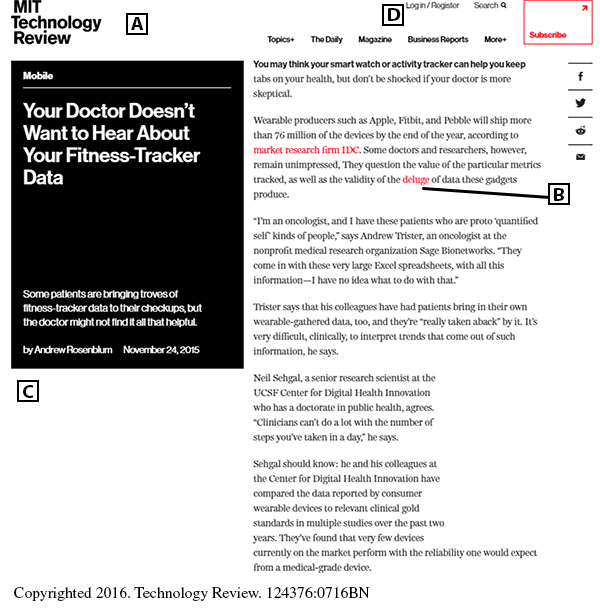Chapter 9.
9.1 Chapter 9: Genre Talk
Click to enlarge the images and view the Web article and journal article, which evaluate the usefulness of fitness trackers. Check your understanding of genre by answering the following questions. Then “submit” your work.


This is a screenshot of the article from the DailyMail.com website. The article title reads: Does your fitness band really work? Scientists analyse tracking tech and find Fitbit and others 'no more effective than a $25 pedometer.' A bullet list below the article title reads as follows: -$99 BodyMediaFIT was top, but still had a 9.3 error rating -Fitbit Zip and Fitzip One next most accurate -All but one band was more than 10 per cent out when estimating calories burned The byline reads: By Mark Prigg PUBLISHED 15:07 EST, 9 June 2014, UPDATED: 08:33 EST, 10 June 2014 Social media and the comments icons and appear below the byline and to the right. A sidebar listing the daily headlines also appears on the right side. The article text reads as follows: Fitness tracking bands have become the must-have accessory for fitness fanatics - but scientists have revealed they may not be as accurate as you think. Researchers tested several of the most popular models, with participants taking part in 13 different activities, including running and playing basketball. They said the results showed the bands were at best reasonably accurate, but that most were more than 10 per cent out when estimating calories burned. Below the article text is a chart titled Does Your Fitness Band Really Work? The chart is divided into four columns. The first column includes the name and an image of each different type of fitness band. The second column lists the price of each fitness band. The third column describes what each fitness band tracks. The fourth column lists the error ratings for each fitness band. The chart reads as follows: Row 1: BodyMedia Fit; Price: $99; What it tracks: sleep, sweat, calories; Error rating: 9.3% Row 2: Fitbit Zip; Price: $59; What it tracks: steps, calories, distance; Error rating: 10.1% Row 3: Fitbit One; Price: $99; What it tracks: steps, steps, calories, stairs, sleep; Error rating: 10.4% Row 4: Jawbone Up; Price: $149; What it tracks: steps, steps, calories, stairs, sleep; Error rating: 12.2% Row 5: Actigraph; Price: $225; What it tracks: acceleration, energy expenditure, met rates, steps, heart rate, sleep, light levels; Error rating: 12.6% Row 6: DirectLife; Price: $199; What it tracks: movement, calories; Error rating: 12.8% Row 7: Nike Fuel Band; Price: $119; What it tracks: movement, Nike fuelpoints; Error rating: 13.0% Row 8: Basis Band; Price: $199; What it tracks: activity, sleep, stress and heart rate; Error rating: 23.5%"
This is a screenshot of the MIT Technology Review website. The heading MIT Technology Review is at the top left. Log in/Register and a search bar are at the top right. Also listed across the top right side are the website's sections: Topics+, The Daily, Magazine, Business Reports, More+. Social media icons appear in a column on the far right. A label of the letter A appears to the right of the MIT Technology Review heading. A label of the letter D appears next to Log in/Register. The article title appears on the left under the heading in a black box and reads: Your Doctor Doesn't Want to Hear About Your Fitness-Tracker Data. Below the title, in the black box, is additional text that reads: Some patients are bringing troves of fitness-tracker data to their checkups, but the doctor might not find it all that helpful. The byline also appears in the black box and reads: by Andrew Rosenblum, November 24, 2015. A label of the letter C appears below the black box. The article text appears on the right side of the page. A label of the letter B appears to the right of the article text, and a leader line points to the red highlighted word deluge (in the sentence They question the value of the particular metrics tracked, as well as the validity of the deluge of data these gadgets produce.). The article text reads as follows: You may think your smart watch or activity tracker can help you keep tabs on your health, but don't be shocked if your doctor is more skeptical. Wearable producers such as Apple, Fitbit, and Pebble will ship more than 76 million of the devices by the end of the year, according to market research firm IDC. Some doctors and researchers, however, remain unimpressed. They question the value of the particular metrics tracked, as well as the validity of the deluge of data these gadgets produce. I'm an oncologist, and I have these patients who are proto 'quantified self' kinds of people, says Andrew Trister, an oncologist at the nonprofit medical research organization Sage Bionetworks. They come in with these very large Excel spreadsheets, with all this information—I have no idea what to do with that. Trister says that his colleagues have had patients bring their own wearable-gathered data, too, and they're really taken aback by it. It's very difficult, clinically, to interpret trends that come out of such information, he says. Neil Sehgal, the senior research scientist at the UCSF Center for Digital Health Innovation who has a doctorate in public health, agrees. Clinicians can't do a lot with the number of steps you've taken in a day, he says. Sehgal should know: he and his colleagues at the Center for Digital Health Innovation have compared the data reported by consumer wearable devices to relevant clinical gold standards in multiple studies over the past two years. They've found that very few devices currently on the market perform with the reliability one would expect from a medical-grade device."